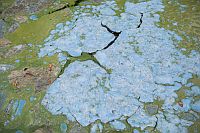
Photo: Ryan Stone for The New York Times
A massive blue-green algae bloom has hit Florida’s “Treasure Coast,” coating the beaches and inlets with a foul-smelling, sticky green-goo that some resident describe as “guacamole thick.” A state of emergency has been declared the Lee, Palm Beach, Martin and St. Lucie counties, the four counties hardest hit by the stinking, oozing muck.
There is no secret as to the source of the problem. This is not the first algae bloom although many consider it to be the worst. Fingers are pointing at the state and federal governments and the out-sized political influence of “Big Agriculture,” specifically the sugar industry. To quote Walt Kelly’s cartoon Pogo, “We have met the enemy and he is us.”
The algae bloom originates 35 miles inland at Lake Okeechobee. A series of antiquated dikes and locks are maintained by the Corp of Engineers to keep the lake from overflowing and flooding neighboring communities. When the water in Lake Okeechobee rises too high, the Corp releases water from the lake to rivers and lagoons downstream, which eventually dumps into the ocean. When these waters hit brackish coastal waters, the pollutants in the lake water, particular agricultural fertilizers, trigger giant phosphorescent plumes of algae, which kill fish and other sea life. The blooms are also unsafe for humans, affecting the gastrointestinal system, liver, nervous system and skin, according to the Florida Department of Environmental Protection.
Lake Okeechobee is now at a ten year high, a foot higher than it was in 2013, the last major algae bloom, and it is not yet hurricane season. The blooms could easily get worse before they get better. One answer is to allow the lake water to drain to the south toward the Everglades. The state has been attempting to purchase land to allow this to happen for several years.
As reported by the New York Times: Mark Perry, executive director of the Florida Oceanographic Society, based in Stuart, said the state’s inability to close a deal to purchase thousands of acres of land south of Lake Okeechobee — to create a natural runoff from the lake into the Florida Everglades, where the diverse ecosystem could naturally filter toxins from the north — has been to blame for the problems being experienced by communities west and east of the lake like Stuart.
But the area south of the lake has been controlled by sugar farmers for decades, and environmentalists like Mr. Perry say state legislators in Tallahassee kowtow to agricultural lobbyists who fund their re-election campaigns.
“The flow used to go south to the Everglades, and now this is a man-made, criminal disaster,” Mr. Perry said. “They, as in the state and federal government, say they can’t send the water south, but they can. This is an absolute atrocity that they are allowed to continue this in the name of agriculture. This is the worst I’ve ever seen it.”
The 2016 sugar harvest was the longest on record because of rain delays, making it also one of the most profitable on record, resulting in 2.15 million tons of sugar. Under Mr. Scott, the board of the South Florida Water Management District failed in 2015 to carry out a plan to buy roughly 47,000 acres of land from U.S. Sugar south of Lake Okeechobee that would have acted as a reservoir for the lake’s runoff.
“The political leadership has not been putting the demand on the agencies to fix the problem,” Mr. Perry said. “This water was never meant to go east and west — it was meant to go south.”

It’s bad in Lake Erie too, but not that bad.
All the farm runoff from other states and Canada runs into the great lakes and drain into Lake Erie, which is the toilet bowl for the upper 3 lakes.
I think it was last year that Toledo had to send in water for people to drink, because the algae was so bad.
It’s not hit us yet, but we’re only 90 miles away.
Mr. Perry may be both correct and incorrect as to the flow directions. The south flow may be possible but not permissable under Federal Laws to protect the Everglades. It is usual to blame the Sugar Industry here in South Florida for the environmental disasters but this to some degree maybe unjustified. Environmentalists are not always hydrologists and their passion, however well intended, may blind them to some science facts.
Having lived to the east of the Everglades for 40 years it was my understanding that these are fresh water algae blooms and are killed off by salt water. The Everglades is fresh water so one would assume the blooms would thrive in the Everglades, where the natural south water flow (River of Grass) has been increased in the last decade, adding to its destruction.
Good Watch.